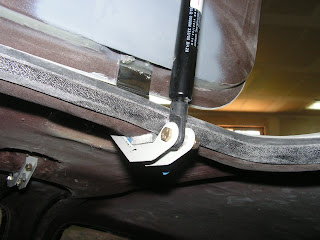First I never could get the Van's door seals to fit correctly. So, following what other RV10 builders have done I installed McMaster Carr seal material it's part number 1120A311.

As you can see it gives a nice seal.
Of course with any modification there is extra work. First the door frame needed to be trimmed to fit the new seal.


Also, the door hinge area on the top of the door must be covered to provide a new seal landing over the hinges. I used fiberglass scrapes left over from trimming the door and epoxied these into place and glassed over them.


Now this creates a new challenge. The frame mount for the gas strut hits the the new door seal area. To solve this, I choose to make new strut mount landing that moves the strut mount down by 1/4". These were made from 1/4" aluminum blocks and filled in around them with epoxy and flox. (One other possible fix is the make the area over the rear hinge convexed to clear the strut mount.)


I have to say I am pleased both with the appearence and the fit.

One other small fix has to do with the locking rods and locking gear rack. On a few other RV-10 I have noticed some surface damage to the inner door panel casued by the pin that is safety wired to the gear rack and door lock rod. In fact, if you look at the picture below note the area were the grey primer is visable. To solve this interference I installed a small washer on the back side of the pin before finishing the safety wiring the pin in place. The washer keeps the pin from sticking out and hitting the inner fiberglass panel.
One other quick mod was having the door hinges chromed by a local shop and replaced the supplied steel screws with structual stainless hardware from Aircraft Spruce. At the same time I also had the two bolt that hold the front sholder harnesses to the cabin top chromed as well.
The cabin top hinge pockets where also fill in to fit snuggly around the hinges. This is done by appling packing tap over the hinges, bolting them in place and filling the void with epoxy and flox. If you do this make sure there is enough area around the hinge for the thikness of the paint.













































